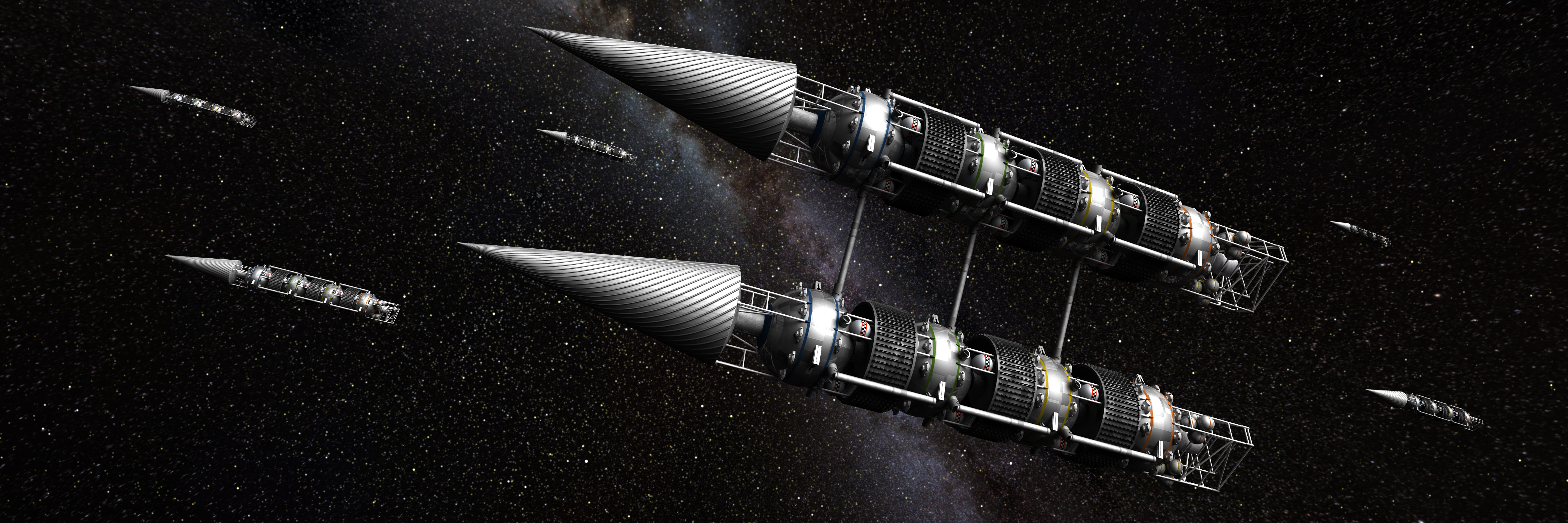Robert Duncan-Enzmann
Drop Your Buckets Where You Are! is a story from history past, from the 1500’s, as Portuguese-design caravels were being displaced by galleons. It tells of a small ship that just emerged from the usually cloudless North Tropical: that ‘ocean desert’ called the Horse Latitudes. So hot and dry is it that horses – creatures that must have water – on their way to the New World were often blindfolded and tossed overboard. The ships couldn’t carry enough water for them.
It’s said, several times, small ships offshore from the mighty freshwater Amazon, appealing to a passing ship for water, were signaled: “Drop your buckets where you are.” Then: “We don’t taunt you. The water is fresh, you’ll be surprised – try it!”
Is there a parallel in the Ocean of Interstellar Space? Is there a way of reducing the perfectly dreadful mass ratio of payload and ship to fuel-&-reaction-mass? The best estimates are, to this day, still 1000 to 1 or more.
A parallel is at least possible. The ocean between stars isn’t empty.
Note: There are many ways of somewhat reducing ship-&-payload ration to fuel-&-reaction-mass. Here we mention that while solar plunging excels as a way of reducing mass needed for acceleration and deceleration, think how wonderfully better our situation would be if our Earth and Sun were in a globular cluster.
Operation of Key Fission Reactors at Relativistic Velocities
Small fission reactors will supply starships’ internal power needs. None have considered reactor structures to operate when the ships cruise (hopefully they will in the nearer, rather than far-off future), or just coast at relativistic velocities.
The problem occurred to me when working on hot pressing beryllium oxide components for America’s ANP (it stands for aircraft nuclear propulsion, an eminently practical system. Aircraft will no longer spew out excess fuel over metropolitan areas. Ever wonder why there are so many more children with asthma around airports? Aircraft fires will no longer cost countless lives, air transportation will be enormously cheaper).
Realizing, Engineering – Interstellar Hydrogen Scoop
My friend and colleague of many years, Bussard, originated the concept of scooping hydrogen from the interstellar continuum with nets of gossamer wires – tens to over a hundred kilometers in diameter – shaped magnetic fields scooping hydrogen into a fusion reactor. There are one or more hydrogen atoms per cubic centimeter of average galactic interstellar space. Moving at about 1/10 light’s velocity, significant proton mass can be collected per unit time.
Expanding on Bussard’s considerations I have studied the possibility of using laser light rather than a material net to do the scooping. A net of light escapes other problems: corrosion by dust, net tangles, breaks, the need for complex control of electric currents to keep the Scoop deployed and properly shaped, the impact of uncharged particles on the net, the difficulty of running large amperage through thin wires, local heating, and rupture of wires cooled to be superconductors. [See athodyde]
Fuel:
Varieties of ‘Echo’ propulsion could use a variety of fuels to generate thrust:
1 – Fission
2 – Fission-Fusion
3 – Augmented Fission-Fusion (such as boron injection)
4 – Fission
It’s how fuel is used that makes an ‘echo’ engine, not the fuel. It’s an idea I developed over a half-century ago; I wonder if it’s really original. It recalls considerations of relativistic engines and their power plants of a half-century ago. Those were the years when technology really surged forward. Sadly, they were followed by decades of implacable hatred and suppression of technology, “as long as we have social problems.” (Who’s we?) These were the days when we were technically five to ten years away from manned exploration of the entire solar system.
Velocity is Relative to What?
Lorentz’s t = t0(1- v2/c2) ½ is referenced to the centroid of visible galaxies and/or background radiation @ 2.70 K.
It works. It’s acceptable. It avoids both the thesis that we must transform Sagnac’s experiment, current optical gyroscopes, and centrifugal force out of existence (accomplished by rotating the universe about the gyro, which is mathematically O.K. as the rotations are imaginary) and concurrently avoids the centuries-long and century-long discredited antithesis that there’s a body, a sky hook of sorts, to which absolute motion is referable.
Profound are the implications and beautifully expressed by Groucho Marx: Are you going to believe me? (Thesis) – or what you see with your eyes (antithesis)!
Ergo, a ‘synthesis’ is possible. Reference visible galaxies as a centroid, and/or the 2.70 K background radiation, and/or apparent recession of galaxies as x, y, z, t centroids. There are other ways too.
Slow Engines
When time runs like molasses, cool, then cold, so does everything else in that inertial frame. At extreme relativistic speeds affairs aboard – spelling bees, ball games, pulling on a pair of socks, and a spectrum of organic activities that modest good taste precludes us from listing, all slow down so that, could they be seen from Earth, would look like the snoozers in Sleeping Beauty’s castle.
Imagine being in an accelerating starship just reaching a velocity where time-dilation (stretching out, slowing down) can be appreciated. At the same time, its engineers notice its power plant and propulsion slow-down.
Relative to the centroid of visible galaxies, 2.70 K background radiation, the apparent recession of galaxies with distance and other measurables, more power is needed to maintain a steady rate of acceleration relative to the centroid. How will this be done? Should engines be ganged, and/or power doubled, quadrupled, etc.? Is there another way around this?
There’s A Way and Here’s How
To myself, I’ll write what I please – so there! Those who see correct solutions and in difficult situations dare exclaim the equivalent of “here’s how,” stir memories of a real happening and a joke. Ever so long ago after operational testing of a major weapons system, at the last and final field test called “handover,” we were faced with a multitude of colonels, a few generals, and a 2nd lieutenant.
I “ask”: “Who the — lieutenant, are you ????”
He replies: “Watch me.”
We watch. Magnificent. Had he been with us, we would, in no time, have willingly worked under him.
In a fictional college, an architect defending his doctorate answered all questions flawlessly, easily, and extensively without hesitation. There was but one irritation. With each answer, he somehow always mumbled, said, or implied: “THAT’S EASY.”
At last, a great professor rose to say: “You have, of course, passed; however just as a profound intellectual exercise I have one last question. Is it possible there’s an easy solution? In this unfortunately inflationary year of the Lord, you are to build a one-family two-bedroom house for a barely possible price in which you’ll design a kitchen where fats don’t spatter and an odorless bathroom! The student interrupts exclaiming: “THAT’S EASY, cook in the bathroom.
Slow Time
As starships cruise at the edges of relativistic space-time struggling to accelerate, as their engines struggle to produce more and more thrust through slow and slower time, moving toward unreachable no-time, their power plants do the same. Time slows down for the ship’s company, and at the same time, the ship’s power plant and thrust slow down when the opposite is needed.
If somehow a ship in relativistic space can operate its power plant and propulsion units in non-relativistic space, neither power production diminishes, nor would its propulsion units generate less-and-less thrust per unit time – an extraordinary requirement indeed. Is it just that: “Oh how we wish something like that could be – if only it were possible?”
It isn’t just wishful thinking. Can a power plant and thrust reactor be inside and outside a ship at the same time? Yes.
Echo Lance, An Inside-Outside Drive
It’s physically feasible and within our world’s current engineering capabilities. This is the nature of the echo lance. Interstellar hydrogen, some helium, and traces of other elements are scooped with a funnel of photons. Fission, fission/fusion, or fusion takes place in an athodyde. The frame and the athodyde travel in relativistic space. Transformation of mass into energy, though shrouded in the athodyde, is in a non-relativistic space. Thrust from fission/fusion “burn” is applied to the ship largely through magnetic cushions and other devices as appropriate.
A row of stationary people along a rinkway can accelerate someone on roller skates if each pushes him as he passes. They are motionless, outside his “frame,” and he is moving.
Can an engine be built in which fission/fusion thrust is within the ship, yet inertially outside it?
Yes, it can be done.
Fuel + Reaction Mass is Heavy
The earliest designs for starships were largely by my dear colleagues and friends, a half-century ago. Dr. Ted Taylor and Dr. Ulam calculated that with engineering then available, nuclear pulse-propelled starships could have been built and reached velocities of 10% or more of light’s velocity. I had several discussions with Dr. Draper about communication at interstellar distances of 5 to 20 light years. Even in the 1950 Draper (far senior to and vastly more experienced and better informed than the writer) and the writer knew TV frames could be transmitted to Earth from such depths in space.
Joanna, while still a student at M.I.T., was employed first with Draper. I will, after decades of silence, here venture that after WWII Draper was heartily disliked by persons violently opposed to American research concerning, much less proto engineering of, intercontinental missiles carrying nuclear warheads. Tomes were written demonstrating that no rocket could possibly hoist a nuclear warhead, and, furthermore, the guidance of a rocket is essentially impossible.
Guidance for Americas ICBMS was finally designed in the Draper Laboratories.
It was estimated that, at best, fission might be 4-5 % effective, and likely significantly less. We estimated interstellar probes would have fuel/reaction-mass ratios of over 1000 to 1. That’s to say, for each ton of ship, at least 1000 tons of fuel and perhaps more.
Ref: Lienard, L’Eclairage Elec XVI, 1898
Ref: G. Schott, E. M. Radiation, 1912, Cambridge University
Ref: Proc. Royal Soc., Larmor’s Collected Papers, 1913
Ref: A. Compton Physical Review 21, 1923
Ref: P. Debye, Physical Zeitschrift, 1923 (results identical with Compton’s)
Ref: C. Raman, India Journal of Physics, 1925, 2 March, (in addition to Compton-Deybe scatter)
Ref: George Joos, trans, Theoretical Physics, 1959 by Ira Freeman of Rutgers, Hafner, NY
Ref: John D. Jackson, Classical Electrodynamics, 1962, Wiley & Sons (concerns “beam topple”)
Ref: Arthur Beiser, Concepts of Modern Physics, 1967, McGraw Hill
Ref: Energy Matter Conversion Co., Tri Alpha Energy, 2000 (use of boron fusion fuel)




